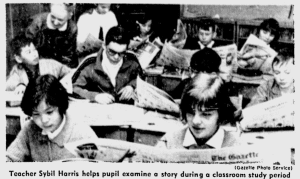In the 1960s, students from Ahuntsic School visited The Montreal Star and The Gazette; The Montreal Star folded in 1979; other newspapers across North America have folded more recently
I’m pleased to share some additional great photos from Ahuntsic School – courtesy of Gina Cayer (MCHS 1967).
As I was working on this post, I thought about the fact that if something appeared in a newspaper in the 1960s, the newspaper’s depiction of reality had about it a certain air of authority. The same was true in decades past of depictions of reality that appeared in network TV news broadcasts. The air of authority that was once associated with newspapers and network TV has long ago disappeared. That’s something I’ve been thinking about as I’ve been working on this post.
First, a few words about Ahuntsic School.
I’m aware – from comments at two MCHS Facebook groups – that there’s a lot of interest among Malcolm Campbell High School graduates – many of whom attended Ahuntsic before arriving at MCHS – in learning more about Ahuntsic.
Among the photos Gina Cayer has shared with us is one that depicts a visit in 1962 by a class to the offices of The Montreal Star. The photo is from a reading enrichment program for the Grade 7 class taught by Mrs Harris. The students visited The Montreal Star and then made a mock up of a newspaper. The reference to the newspaper prompted me to find a New York Times article which describes how the The Montreal Star folded in the late 1970s.
The Montreal Star folded in 1979 (an attempted revival, described in this 1979 article, did not work out)
A Sept. 26, 1979 article by Deirdre Carmody from the online archives of the New York Times is entitled, “Montreal Star Ceases Publication After Loss of Circulation in Strike.” The article reads:
About the Archive
This is a digitized version of an article from The Times’s print archive, before the start of online publication in 1996. To preserve these articles as they originally appeared, The Times does not alter, edit or update them.
Occasionally the digitization process introduces transcription errors or other problems; we are continuing to work to improve these archived versions.
The Montreal Star, an afternoon newspaper that has been struggling to regain circulation lost to a morning rival during an eight‐month strike, announced yesterday that it was ceasing publication because of heavy financial losses.
However, there was hope that The Star might reopen soon under joint ownership with its rival, The Gazette.
Arthur E. Wood, publisher of the 111 year‐old daily, said in a statement that “cessation of publication of The Montreal Star is a direct consequence of enormous losses experienced by The Star.” The Star was closed by a pressmen’s strike that began in June 1978 and ended in February.
According to figures from the Audit Bureau of Circulation, The Star’s daily circulation fell from 166,000 before the strike to 114,000 for the three‐month period ended June 30, 1979, and its Saturday circulation fell from 233,000 to 150,000. The Gazette’s daily circulation is 167,000 and its Saturday circulation 203,000. In Canada, the Saturday paper is equivalent to the Sunday newspaper in the United States.
“The closing of The Montreal Star at this time is a great tragedy,” Mr. Wood said.
However, Mr. Wood said an agreement had been reached between F. P. Publications, Ltd., which owns The Star, and Southam Inc., owners of The Gazette. Under the agreement, The Gazette will buy the newspaper assets of The Star, and F. P. Publications will buy a one-third interest in The Gazette. Trading in Southam securities was halted yesterday on the Toronto Stock Exchange pending an announcement from the company.
Mr. Wood said the pressmen’s strike had caused losses of $7 million for The Star. Since it resumed publication, Mr. Wood said, it has lost $10.4 million more. He said that the losses contrasted with The Star’s earned pretax profits in 1976 of $5.7 million, the highest in the newspaper’s history.
The Star, which was founded in 1869 by Hugh Graham, Lord Altholston, allegedly with just $100, became one of Canada’s leading newspapers. Until the end of World War II, Montreal was the premier city in Canada in terms of both culture and business, and The Star was the Establishment paper. After the war, however, the increasing American business presence began to turn to Toronto, which was geographically closer to the American heartland and the mass markets of the Midwest.
In 1976, the election of Premier René Lévesque and the Partie Québécois on a platform seeking to separate the English-speaking and French‐speaking communities led many members of the English-speaking community to leave Quebec.
The pressmen’s strike, over manning requirements and wages, was really the death blow for The Star. During the strike, The Gazette made a number of improvements, and when The Star resumed publication it found that many of its advertisers and readers had gone to the morning paper. It made some gains but never approached its former dominance.
Robert McConnell, publisher of The Gazette, said in an interview yesterday that as soon as The Star completed termination arrangements with its unions and employees, The Gazette would move into The Star’s building and attempt to revive The Star as an afternoon daily under joint ownership but with editorial independence.
A few weeks ago, The Star announced plans to insert into its editions the business and financial news section of The Toronto Globe and Mail, which is also owned by F. P. Publications. This was believed to be a first in North American journalism.
A Sept. 25, 2018 CBC Archives article is entitled “When [T]he Montreal Star’s long history came to an end: Century-old paper folded after losing money and losing ground to competition.”
The articles bring to mind the current situation involving newspapers across North America. Newspapers used to have a business model based upon the sale of advertising. Now online corporations such as Google and Facebook have command of advertising revenue; newspapers are increasingly in a position where a viable business model appears to be out of reach.
Boyce Richardson
When I think of The Montreal Star, I’m reminded of Boyce Richardson, a Canadian journalist who’s written extensively about the history of land use decision making in the Cree territory of northern Quebec. He worked for a while as a reporter at The Montreal Star but then decided to quit, because it was clear the newspaper would never print the kind of stories he wanted to write – he would need to seek other places to get his work into print.
Students from Ahuntsic School also visited The Gazette in the 1960s
A Feb. 7, 1966 Gazette article is entitled “Ahuntsic School uses The Gazette for teaching.”

Feb. 7, 1966 Gazette article. Caption reads: Teacher Sybil Harris helps pupils examine a story during classroom study period. Source: Gazette Photo Service
The article reads:
Children at Ahuntsic School are finding that there’s an education to be had from their morning paper.
Their teacher, Mrs. Sybil Harris, has been using The Gazette as a supplement to textbooks for their reading course.
She says that using a newspaper helps the child learn to read and also develops a sense of worldly awareness and civic responsibility.
Principal E. M. Kogut explained that the use of newspapers was to complement the Joplin reading program used by the school.
The Joplin program, so named because it was invented some ten years ago in Joplin, Missouri, adapts reading to the child’s learning speed and largely eliminates textbooks.
“We’re partisans of the ‘activist’ method of learning,” said Mr. Kogut. “The child is learning by doing. We feel that for our more qualified students, reading should be a challenge.
“Using The Gazette is an excellent way of providing this challenge.”
Both principal and teacher stressed that the Joplin method not only teaches the child to read words but also gets him to understand and criticize what he is reading.
For homework, the children are asked to read The Gazette, provided by the school, and be prepared to discuss certain articles the next day.
Stories summarized for class
The class, Grades 6 and 7, is divided into groups of two or three students. Each group is responsible for a particular section of the newspaper – international, national and local news as well as financial, women’s and sports coverage.
The next day the children are asked to summarize a story they have read in front of the whole class.
“It is really amazing to see 12-year-old children discuss the problems facing Expo ’67 or expound on Messers. Kierans’ and [Wagner’s] latest exploits,”said Mrs. Harris.
Recently boys in charge of explaining the financial section found they were not getting across to their classmates.
The devised a way of explaining the endless numbers in the financial pages on the blackboard.
When they were finished most of their mates knew what all those confusing figures meant.
“They had to do a lot of research and thinking to be able to explain the mechanics of the stock market, but now the whole class has found out something,” said their teacher.
“Using a newspaper keeps them aware of what is happening around them. It also gives them the research training they will need when they go on to high school and college.”
Principal Kogut was enthusiastic about the method and indicated his school would adopt it permanently.
A rapid poll of the students showed that interests were as numerous as students.
Metroland in Ontario ends print editions, September 2023
A Sept. 15, 2023 CP24 article is entitled: “Metroland ends print editions of community papers, keeps regional dailies.” An excerpt reads:
TORONTO – Large swaths of Ontario will lose their local newspapers as one of the country’s largest media conglomerates ends print editions for its community news titles.
Metroland Media Group announced the move to a digital-only model and an end to its flyer business Friday as it revealed it will seek protection and attempt a restructuring under the Bankruptcy and Insolvency Act.
The cuts and restructuring will mean the loss of 605 jobs or about 60 per cent of Metroland’s total workforce.
Staff at Metroland’s six daily newspapers – the Hamilton Spectator, Peterborough Examiner, St. Catharines Standard, Niagara Falls Review, Welland Tribune, and the Waterloo Region Record – will not be affected, nor will those at the Toronto Star, one of Metroland parent company’s NordStar Capital Inc.’s papers. Metroland attributed the changes to “unsustainable financial losses stemming from the changing preferences of consumers and advertisers.”
“The media industry continues to face existential challenges, largely because digital tech giants have used their dominant positions to take the vast majority of the advertising revenue in Canada,” the company said in a statement.
“The decline of the print and flyer distribution business was significantly accelerated by the COVID-19 pandemic, and by the reduction of flyer usage both by readers and advertisers as a marketing vehicle.”
Métro Média to declare bankruptcy
A Sept. 17, 2023 CBC article is entitled: “Métro Média to declare bankruptcy as local journalism takes another hit: ‘The Journal Métro as you knew it no longer exists,’ says Métro Média CEO.” An excerpt reads:
Métro Média will declare bankruptcy this week, permanently ending its coverage of local government in parts of the province’s two largest cities, the head of the Quebec newspaper publisher said Sunday.
In a post on X, formerly known as Twitter, CEO Andrew Mulé said the decision was made after the company abruptly suspended operations at its more than 30 hyper-local publications last month, including the Journal Metro and 16 print weeklies.
“The Journal Métro as you knew it no longer exists. The decision to proceed with the voluntary transfer of Métro Média’s assets has been ratified,” Mulé wrote Sunday.
Democracy and the decline of newspapers – Dale Eisler article
I have written earlier about a book by Dale Eisler about the history of Saskatchewan.
A November 2016 article by Dale Eisler, Senior Policy Fellow, at the Johnson Shoyama Graduate School of Public Policy at the University of Regina, is entitled: “Democracy and the decline of newspapers: Should there be a policy response?”
An excerpt reads:
Clearly, the newspaper industry in Canada is in dire straits. But is the public interest being harmed by a decline in good journalism as a result of a failing newspaper business model? The drop in readership of printed newspapers has been offset by the emergence of almost unlimited digital online sources of information, news and opinions. During the last 20 years, society has witnessed a fundamental change in media consumption habits, away from older, traditional mass media, to new digital sources that include blogs, Twitter, Facebook, news aggregators and literally millions of individual websites, all accessible through web browsers. What we have been witnessing is the unfolding obsolescence of the daily newspaper industry because of the instant, and often free accessibility to news and opinion offered by the Internet.

View of the former Parkview School, photographed from top of Aquaview Condominiums, November 2012. Photo credit: Jaan Pill
Commentary
I find the topic of community news reporting of much interest. I’m pleased that during the years when we lived in Long Branch in Toronto, I was able to demonstrate a measure of agency – working closely with a large number of fellow residents – on matters related to land use planning issues in Toronto. Even after we moved to Stratford, I was able to demonstrate a level of agency – again working closely with Toronto residents – regarding a number of land use issues in Toronto. The land use matters that I refer to include the saving of the former Parkview School and the preservation of a heritage house in Mimico on Wheatfield Road.

View of new main entrance stairs, one of many new, recently constructed landscape features at École élémentaire Micheline-Saint-Cyr – previously named Parkview School, 85 Forty First St. in Long Branch. Jaan Pill photo.
My involvement didn’t occur by accident. For a couple of decades I had earlier been involved as a volunteer community organizer. Just something I fell into. A key ingredient, in taking on such a role, was experience as a freelance writer in the Canadian magazine industry in the late 1970s. I earned almost nothing from such work – it was close to being volunteer work, in fact. The magazine I worked for – Cinema Canada – eventually folded; there was no way to enable such a magazine to remain viable as the years went by. That said, articles that I wrote for the magazine remain as valuable archival resources.
That experience in writing has stood me in good stead. As a volunteer, I later was involved with volunteer media relations – again, the previous experience in magazine (and newspaper) writing came in very handy. I knew how to write a news release. I knew how to ensure that, when answering reporters’ questions, I said what I wanted to say – while ensuring that whatever I said was verifiable. Eventually, around 2010, I set up the current website. That has enabled me to continue – as a volunteer – with the information dissemination projects that have always been of interest for me.
These days, I like to read books. I read them endlessly. I also read news reports online – I find it a great idea to read news and opinion pieces of all kinds. However, I much prefer evidence-based, book-length studies. I’m currently reading The War Came to Us: Life and Death in Ukraine (2023) by Christopher Miller. An evocative, informative study by an American who has spent much time in Ukraine. This is an excellent report on the Euromaidan Revolution in Kyiv in 2013 and all the events that followed. A first-rate overview. I recommend it highly. Books offer a more in-depth view of things. These are thoughts that have occurred to me, as I think about Ahuntsic School of many years ago.






We have an email list, set up some years ago, which we use for the planning of upcoming MCHS picnic lunches in Toronto and Southwestern Ontario. The next picnic is in Woodstock on Oct. 4, 2023. (Contact me if you have a connection to MCHS and wish to be on the list.) At a recent email I shared a link to the current post.
One of the members of the email list, Philip Bristow, sent me the following message of interest on Sept. 19, 2023 (he has me given permission for me to post it here):
I have several connections to today’s post.
My brother Jim and I began our education at Ahuntsic School from 1950 to 53 before we moved to Rosemere.
I worked a with The Star Fresh Air Fund for two summers in 1968 & 69.
And Jim and his wife, Carol were among the last employees to leave the paper when it folded in 1979.
It was a great loss to the city at a time when newspapers were part of the lifeblood of the community giving back in more ways than just the news. We loved our association some wonderful people there.